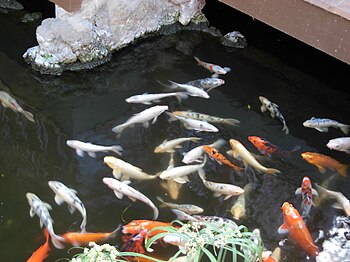 |
| Pennant coralfish (Photo credit: Wikipedia) |
These fish bear a strikingly similarity to the Moorish idol. They are narrow and triangular in shape with two thick black, vertical stripes contrasting against their white bodies. The first tripe is just behind the head. The second is located just prior to the base of their caudal fin. Their caudal, anal and pectoral fins are bright yellow in color. They have a long sickle-shaped crest the top of their dorsal fins that extends well past their tail just like their look-alikes.
So why is their resemblance to a Moorish idol of any significance? The exotic elegance of the idol makes it a very desirable choice among aquarists. Unfortunately, idols are one of the hardest marine species to maintain in captivity. Many expert aquarists can't manage to keep Moorish idols alive and healthy. Whereas the longfin bannerfish is one of the easiest fish to raise in a saltwater aquarium.
You get the exotic look you are after without investing in a recipe for disaster. Longfins are in fact commonly referred to as "the poor man's Moorish idol," within the aquarium trade. Longfins are not considered less expensive than Moorish Idols. But they are much more likely to still be alive a year from now. This makes them a much more economical species. Longfin Bannerfish is also marketed under the names black and white butterflyfish, black and white Heniochus, and pennant coralfish.
Pennant coralfish are relatively large fish. They grow to a maximum adult length of 10 inches although 7 inches in length is more typical. This is a very active and robust fish. A minimum tank size of 55 gallons is recommended. If you intend on keeping them as community fish you will require at least a 100-gallon aquarium. These are peaceful animals and should not be housed with more aggressive species.
They are a shoaling fish by nature and will mix well with other members of their species in the confines of an aquarium. There is a distinct possibility that they will establish a dominance hierarchy when first introduced into an aquarium. There may be a little bit head-butting until the pecking order is established. These fish may demonstrate territorial behavior toward other butterflyfish species. Pennants do not make particularly good marine reef fish. They have a tendency to nip at soft corals and smaller invertebrates. Pennants are mid-level to upper-level swimmers in an aquarium. They may live in excess of 5 years in captivity.
Longfins are omnivorous. They are primarily zooplankton feeders in their natural habitat. They generally acclimate quickly to aquarium foods. They will readily accept both flake food and pellets. As with all marines species, a varied diet will help avoid nutritional deficiencies and maintain overall fit and vigor. Frozen or freeze died preparations for marine omnivores is a good start. A good supply of well-established living rocks and dried algae sheets will help to round out their diets.
There are no distinguishing traits between the males and females of this species. These fish rarely breed in captivity.
Technological advancements in the aquarium industry continually redefine the concept of "home aquarium ownership." Just twenty years ago not even the biggest public aquarium was capable of keeping jellyfish alive in captivity. Now they make desktop Jellyfish Fish Tank Aquariums. And why would you want a jellyfish tank? Perhaps you should check out what the translucent bodies of Pet Moon Jellyfish look like under LED lighting. Pet Jellyfish give a whole new meaning to the term exotic pets.
Article Source: EzineArticles
|






